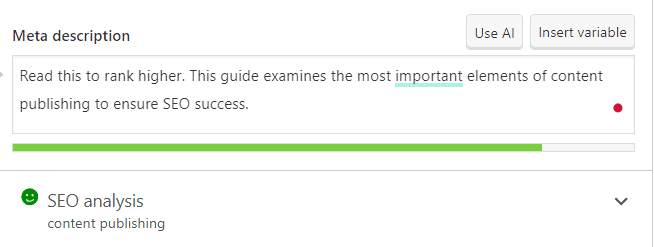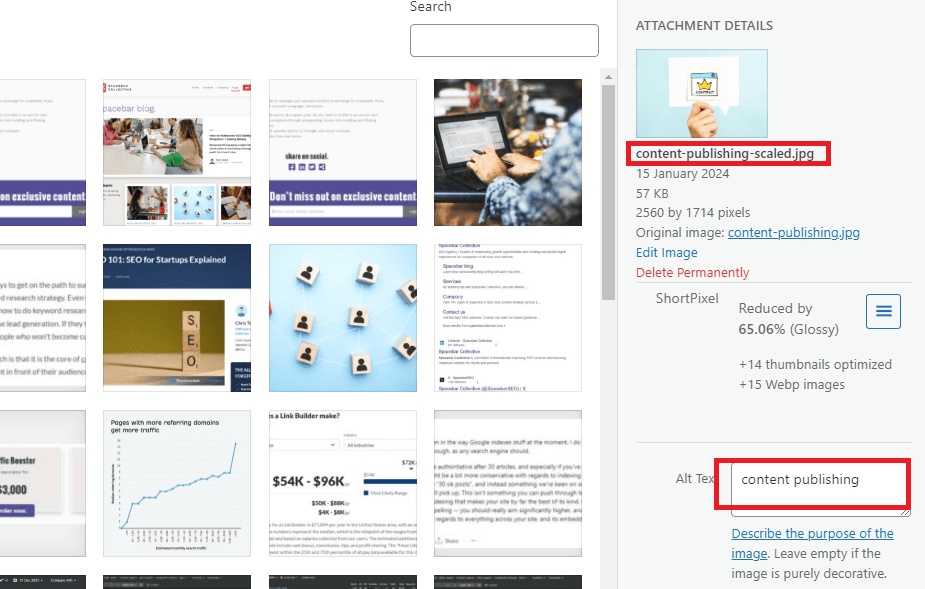Writing content for your website is a lot of work before you think about publishing content. For SEO campaigns to be effective, the publishing process is almost as important as the content itself. There’s more to it than counting keywords.
In this article, we’ll share the essential content publishing best practices you should employ whenever you publish new content on your website. It’s a guide that will improve your SEO strategy and offer some practical tips you can implement immediately.
- Is there a right way to structure content for SEO?
- Should you use internal and external links in your content?
- Are there any tools that can help with content publishing?
Keyword Optimization
There are two critical parts to keyword optimization. There’s the research stage, and then there’s the implementation stage.
During the research stage, you should identify keywords and themes. Tools like Google Keyword Planner, Semrush, or Ahrefs can help. These tools help you understand search volumes and unearth phrases you might not have considered.
The next stage is implementation, a vital part of your content publishing process. The primary keyword should be included in the meta title. It should also be in the meta description and the URL slug. Additionally, it should appear in headers and naturally in the content. Natural insertion is important. Strong arming keywords into text reads awkwardly and certainly won’t help from an SEO point of view.
Keywords embedded naturally in your content help search engines understand and rank it. It’s a win-win: your audience appreciates the accessible content, and the algorithm looks kindly on the published piece.
Content Structure and Formatting
How your content is structured matters for user experience and SEO. Content with clear structure, including headers and concise paragraphs, will rank much higher than long, unorganized text. It’s important to note that search engines understand the hierarchy of headers. So use H1s for your main title, H2s for larger article sections, and H3s for subheadings. This appeals to search engines as they understand the content through the H tags, but also to users who can navigate larger texts at a glance.
Smaller paragraphs make longer articles far easier to read. Ideally, a paragraph shouldn’t be more than 4-5 lines. You should also consider breaking down ideas using bullet points and numbered lists. These are visually appealing and make the content far more accessible.
Meta Length
While considering formatting, the length of your meta title and description matters. The perfect meta title should be 40-60 characters long. Any longer, and it’ll be truncated by search engines. Meta descriptions should be 120-160 characters long.

Use of Images and Alt Text
Images should accompany every article that you publish. Images help to break down what would otherwise be a long wall of text but also keep the reader engaged in the content. An engaged reader really helps with SEO. Their reduced bounce rate and increased dwell time are both great signals to search engines.
When publishing the images in your content, there are certain best practices that you should consider:
- Optimize the image by compressing it. Smaller file sizes mean pages load quicker, but make sure you’re not compressing to the point that the quality of the image is affected.
- Adding keyword-inclusive alt text helps to make the content accessible to those using screen readers. Plus, it helps search engine crawlers understand what is in the image.
- Spread your images throughout the text and keep them the same size. Aim for an image per 500 words of text.
- Use a featured image when publishing content so social media posts and search engines can use it.

Internal and External Linking
You should incorporate links in two ways when publishing content: internal and external.
Internal links are links from your content to other pages of your website. These keep readers engaged and within your website. This amounts to longer visits and additional value to the user. It’s a level of interconnectedness that search engines love. A good rule of thumb is to include 3-4 internal links per 1,000 words of content.
External links are links from your content to other websites. It’s a way of enhancing your content through credibility. When you link to another source, it shows that you’re using reliable information, or at least trying to. These links make your content far more trustworthy and improve its value. Plus, when you link to another website, they might choose to link back to you, providing a backlink-building opportunity.
Clean Up The Slug
Most CMS will automatically pull the slug from the meta title. This often means the URL is long and sloppy. We recommend changing the slug to match the exact keyword.
For example, if your CMS auto-completes the slug for you, it might look like this:
https://spacebarcollective.com/content-publishing-best-practices-for-seo
Content with clean, concise slugs are easier for Google to index. We recommend correcting the slug like this: https://spacebarcollective.com/content-publishing
Accuracy
Before hitting the publish button, make sure that you have thoroughly checked the following:
- Spelling and grammar are correct
- Punctuation and capitalization are consistent throughout
- Improper spacing has been removed or edited
- Formatting is consistent
- The intro is well-written and clear
- The outro provides a short summary and call to action
- Tone and style are appropriate for your brand
Adhering to these best practices will yield you quality, well-presented content each and every time.
You should also ensure appropriate backend tasks have been completed, including:
- An excerpt is attached to the content
- Categories have been selected
- The author or publisher’s name has been selected
Many of these aspects can be checked by using a third-party tool. If you’re a WordPress user, using a plugin such as Yoast, RankMath, or All-in-one SEO makes the process a breeze. They include automated checklists and indicate how well you’ve done through a traffic light or numerical score.
Key Takeaways
Content publishing is the culmination of your hard work. You’ve researched the keywords, written the content, formatted it, and inserted images. Now, all you need to do is give the content the care and attention it deserves during publishing. Trust us, the SEO payoff is worth the trouble.
- Be precise with your keywords. You’re looking for quality insertion here rather than quantity.
- Well-structured content is appealing to both users and search engines.
- Consistent linking strategies internally and externally will enhance your content’s authority. It will also boost your content’s expertise.
At Spacebar Collective, we know content publishing matters. We help businesses to publish tens of thousands of words of content each month. We’d love to chat with you and see how we can help you achieve your SEO goals.






